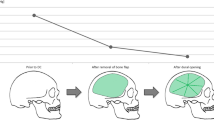Abstract
The high early case fatality among patients with massive hemispheric strokes calls for effective treatments. Release of the restriction created by the dura mater and bony skull to allow the infarcted brain tissue to swell has been successfully adopted by some while considered controversial by others. A recent pooled analysis provides estimates for the efficacy of decompressive surgery. Further analyses of current trial data suggest that in particular patient age and timing of surgery determine outcome. Nonetheless, in order to guide the management of individual patients, carefully adjusted medical care, ongoing futility analysis, and simultaneous caregiver meetings should be conducted to reach a joint decision addressing any ethical concerns. In conclusion, decompressive surgery increases the probability of survival but produces patients with moderate or moderately severe disability (albeit not severe disability). Currently, the decision to perform decompressive surgery should remain an individual one in each and every patient.
Similar content being viewed by others
References
Hacke W et al. Malignant middle cerebral artery territory infarction. Arch Neurol 1996;53:309–15.
Berrouschot J et al. Mortality of space-occupying (malignant) middle cerebral artery infarction under conservative intensive care. Intensive Care Med 1998;24:620–3.
Frank J. Large hemispheric infarction, deterioration, and intracranial pressure. Neurology 1995;45:1286–90.
Rutkow I. Trephination: How did they do it? Arch Surg 2000;135:1119.
Smith ER, Carter BS, Ogilvy CS. Proposed use of prophylactic decompressive craniectomy in poor-grade aneurismal subarachnoid hemorrhage patients presenting with associated large sylvian hematomas. Neurosurgery 2002;51(1):117–24.
Forsting M et al. Decompressive hemicraniectomy for cerebral infarction: an experimental study in rats. Stroke 1995;26:259–64.
Doerfler A et al. Decompressive craniectomy in a rat model of “malignant” cerebral hemispheric stroke: experimental support for an aggressive therapeutic approach. J Neurosurg 1996;85:853–9.
Delashaw JB et al. Treatment of right hemispheric cerebral infarction by hemicraniectomy. Stroke 1990;21:874–81.
Carter BS et al. One-year outcome after decompressive surgery for massive nondominant hemispheric infarction. Neurosurgery 1997;40:1168–76.
Schwab S et al. Early hemicraniectomy in patients with complete middle cerebral artery infarction. Stroke 1998;29:1888–93.
Frank JI. Hemicraniectomy and durotomy upon deterioration from infarction related swelling trial (HeaDDFIRST). Neurology 2003;60(suppl 1):A426.
Vahedi K et al. for DESTINY, DECIMAL and HAMLET investigators. Early decompressive hemicraniectomy surgery in malignant infarction of the middle cerebral artery: a pooled analysis of three randomized controlled trials. Lancet Neurol 2007;6:315–22.
Juttler E et al. Decompressive surgery for the treatment of malignant infarction of the middle cerebral artery (DESTINY) – a randomized controlled trial. Stroke 2007;38:2518–25.
Vahedi K et al. A sequential design, multicenter, randomized, controlled trial of early decompressive craniectomy for malignant middle cerebral infarction (DECIMAL trial). Stroke 2007;38:2506–17.
Hofmeijer J et al. Hemicraniectomy after middle cerebral artery infarction with life-threatening edema trial (HAMLET). Protocol for a randomized controlled trial of Decompressive surgery for space occupying hemispheric infarction. Trials 2006;7:29.
Gupta R, Connolly ES, Mayer S, Elkind MS. Hemicraniectomy for massive middle cerebral artery territory infarction: a systematic review. Stroke 2004;35(2):539–43.
Curry WT Jr, Sethi MK, Ogilvy CS, Carter BS. Factors associated with outcome after hemicraniectomy for large middle cerebral artery territory infarction. Neurosurgery 2005;56(4):681–92.
Foerch C, Lang JM, Krause J, Raabe A, Sitzer M, Seifert V, Steinmetz H, Kessler KR. Functional impairment, disability, and quality of life outcome after decompressive hemicraniectomy in malignant middle cerebral artery infarction. J Neurosurgery 2004;101(2):248–54.
Pillai A, Menon SK, Kumar S, Rajeev K, Kumar A, Panikar D. Decompressive hemicraniectomy in malignant middle cerebral artery infarction: an analysis of long-term outcome and factors in patient selection. J Neurosurg 2007;106(1):59–65.
Chen CC, Cho DY, Tsai SC. Outcome of and prognostic factors for decompressive hemicraniectomy in malignant middle cerebral artery infarction. J Clin Neurosci 2007;14(4):317–21.
Walz B, Zimmermann C, Bottger S, Haberl R. Prognosis of patients after hemicraniectomy in malignant middle cerebral artery infarction. J Neurol 2002;249:1183–90.
Kastrau F et al. Recovery from aphasia after hemicraniectomy for infarction of the speech-dominant hemisphere. Stroke 2005;36(4):825–9.
Mayer S. Hemicraniectomy. A second chance on life for patients with space-occupying MCA infarction. Stroke 2007;38:2410–2.
Author information
Authors and Affiliations
Corresponding author
Rights and permissions
About this article
Cite this article
Carandang, R.A., Krieger, D.W. Decompressive Hemicraniectomy and Durotomy for Malignant Middle Cerebral Artery Infarction. Neurocrit Care 8, 286–289 (2008). https://doi.org/10.1007/s12028-007-9024-0
Published:
Issue Date:
DOI: https://doi.org/10.1007/s12028-007-9024-0




